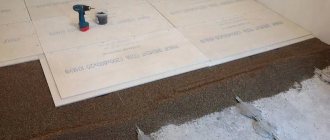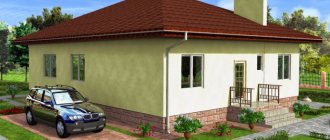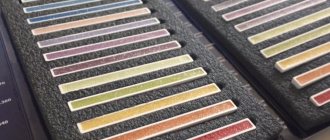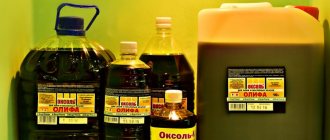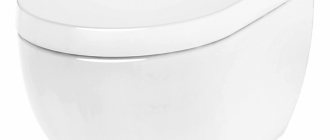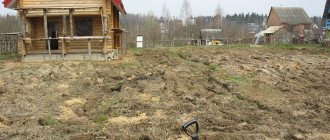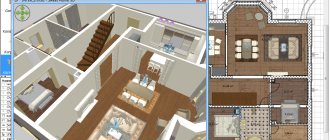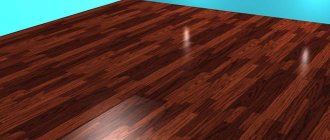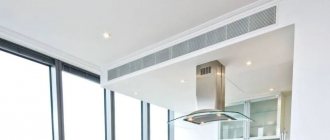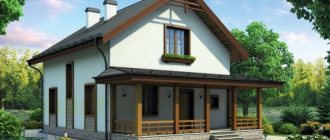→ Materials
In the bathroom, not only the bath itself is exposed to moisture. The floor, walls and ceiling are moistened to maximum levels during water procedures, so the base of the room structures must be constructed from water-repellent materials. The Knauf company offered a new product - “Aquapanel Internal”. What is she?
Essentially, it is a cement board with a fiberglass reinforcing layer inside. During its production, plasticizers are added to the solution, which increase the moisture-repellent properties of the product.
Features and composition of the material
To understand what an aquapanel is, you must first consider its structure. This plate consists of the following parts:
- The inner layer is made of Portland cement and mineral filler. Added plasticizers provide good flexibility of the product, allowing it to be used to finish curved surfaces.
- Reinforcing fiberglass mesh on both sides of the core. Fiber is also present at the ends of the product for greater strength.
- Outer cement shell. On one edge it is glossy and smooth, and on the other it is slightly rough for better adhesion. The finish fits perfectly onto the outer layer; it can be painted and complemented with tiles and other materials.
Building with aqua panels Source sk-kuban.ru
Application area
Aquapanels can be used in cladding living rooms, industrial premises, arranging swimming pools, baths and in the exterior decoration of buildings. Due to their low thermal conductivity, exterior slabs will additionally serve as good insulation.
When installing the slabs, it is necessary to follow a certain technology for laying them, namely, a gap of 3-5 mm must be left between the slabs, which is filled with a special mixture; the vertical joints of each row of slabs should not coincide with each other, that is, there must be a bond.
Methods for fixing slabs
Having understood the concept of aquapanel - what it is and how it differs from analogues, you can consider the methods of installing these products. Most often, a special sheathing made of metal or wood is used for them. Each option has its own advantages. Main functions of the lathing:
- Ability to hide utility lines such as pipes and wires. This allows you to protect equipment from damage, as well as improve the appearance of the interior of the room.
- Insulation and soundproofing of walls. To achieve this, thermal insulation material is used.
- Leveling and hiding surface defects.
Wall decoration with aqua panels Source v-remonta.ru
The better to glue
To seal seams during installation, you will need special glue. The composition usually used here is AQUAPANEL KNAUF . The structure is a one-component polyurethane-based adhesive, which is available in 310 ml .
The composition is completely ready for use. Stated consumption: 25 ml/1 meter of seam . Accordingly, the tube is enough for 6.5 m2 of the treated surface.
Work is carried out only at positive temperatures, drying time is approximately 40 minutes .
After application, the glue increases the reliability of the structure and eliminates the need for puttying, which significantly reduces the work process.
Types of cement panels
Speaking about what aquapanels are, it is important to note that there are many types of these products. Each of them is intended for a specific area of use. Such slabs are usually divided into internal, external and universal. Manufacturers take into account future operating conditions and endow the material with certain useful properties.
Ceiling with aqua panels Source evro-torg.ru
Products for interior decoration
For indoor work, aquapanels with a thickness of 6 mm are very popular. The Knauf company, which produces building materials, has such products. These products are very light, but at the same time quite durable, they are installed without much effort and have a long service life.
Internal type aquapanel Source akvapanel.ru
Knauf aquapanels with a thickness of 8 mm are perfect for finishing a kitchen, balcony or bathroom. They are not afraid of moisture and do not change their shape from spilled liquid. The dimensions of the products resemble gypsum boards, but cement panels have much better characteristics.
The light weight of aqua panels allows them to be used even for ceiling decoration. If you decorate the walls with material, you will get an ideal surface for subsequent finishing work. The slabs can be painted, covered with wallpaper, tiles or other materials can be fixed to them.
External aquapanel
In practice, this type of aquapanel acts as a load-bearing fence in monolithic-frame and frame-wood construction of buildings, or for buildings with a steel frame.
Good examples of using aquapanels in outdoor construction are the installation of ventilated facades, cladding of balconies, loggias, canopies and canopies, construction of garden gazebos, etc.
The external aquapanel is slightly heavier and denser than the internal one (16 kg/m2 versus 15 kg/m2 weight; 1150 kg/m3 versus 1050 1150 kg/m3 density). This is due to the specific nature of outdoor use, where the load on the material is more significant. This material is convenient for installation and subsequent maintenance of the product.
The special properties of aqua panels (the ability to bend without loss of strength characteristics) are used in the creation of non-standard architectural forms and solutions.
How to install products
Before you begin installing cement panels, you need to prepare tools and materials for the job. An aquapanel is a product that does not require too much effort to be placed on the surface. It is enough to use self-tapping screws, glue and putty. The manufacturer Knauf produces products that are specifically designed for these sheets and are ideal for installation:
- Pointed screws, as well as self-tapping screws with a drilling end. The choice of variety depends on the base on which the slab is installed.
- Adhesive reinforcing solution.
- White putty.
Aquapanels on the house Source stroynet.ru
Flaws
In comparison with materials similar in their concept of application, such as plasterboard sheets, aquapanels have practically no disadvantages. The only thing, perhaps, is their cost. However, here too it is necessary to understand that the use of such products in moisture-resistant rooms can save on additional protection of walls from moisture. So the high cost will manifest itself more in those areas of work where the technical characteristics of this finishing material are not critical. Then you can really save money and use the same plasterboards.
The disadvantages also include the fact that the material is relatively new, so few professionals and everyone else have experience working with it for a long time. It is possible that such panels hide shortcomings that we do not yet know about. However, the first reviews from specialists are filled with positivity.
Differences in Dimensions
Wall panels can be produced in three main types:
Slatted from PVC, fiberboard, MDF. The length of the slats is up to 3.7 m with a width in the range of 125-300 mm. The thickness of the boards is usually in the range of 80-120 mm. Used for finishing small spaces. Installation is carried out on a galvanized sheathing or frame made of wooden blocks. For connection, locks are provided at the ends of the blades.
Tiled in the shape of squares or rectangles. The length of the longest side can be 30-1000 mm. Suitable for decoration with the creation of ornaments and designs. The connection is made according to the tongue-and-groove principle. Installation is carried out using glue or special clamps.
Sheet - attached with glue and finishing the joints with moldings. These are long canvases measuring up to 2.4 m with a thickness of 3-6 mm. To increase strength, the material is multi-layered. The color palette is quite diverse; imitation of wood, stone, and tile is popular.
Thanks to the use of wall panels, you can quickly create a high-quality finish in the bathroom. In order not to make a mistake with your choice, you should initially decide on the specific functional areas where the material will be attached, as well as the dimensions and design of the canvases.
Specifications
Rectangular slabs. The size depends on the type of application - external, internal, ceiling, universal.
The plates have the following characteristics:
- Width 900 mm, 1200 mm;
- Length 900 mm, 1200 mm, 2400 mm, 2500 mm, 2800 mm, 3000 mm;
- Thickness 12.5 mm;
- Weight 1 sq. meters 16 kg;
- Bend radius 3 m;
- Frost resistance cycles 75;
- Flammability group NG;
- Density 1200 kg/m3.
The average price of an aquapanel for outdoor use with a minimum size of 900 x 1200 mm is about 812 rubles, an average size of 1200 x 2400 mm is 2220 rubles. The average cost of 1 m2 is 750-770 rubles as of 2019.
Features of Knauf aquapanels
Due to their composition, the slabs are suitable for finishing with plaster or tiles. Features:
- Strength comparable to concrete.
- Resistant to deformation.
- Resistant to chemical attack.
- Fireproof, withstands prolonged heating without igniting.
- Soundproofing material.
- One panel can support about 50 kg of cladding per square meter.
The panels have become an alternative to brickwork. No preparation required for installation. In all respects, aqua panels are superior to their plasterboard counterparts.
In addition to conventional sheets, Knauf produces ready-made facade curtain systems and external walls, which makes it easier to insulate buildings from the outside.
Installation
There are several ways to lay panels:
- using glue or liquid nails;
- on a special frame.
The arrangement of the frame is carried out using an aluminum profile using the following technology:
- the arrangement of profiles is carried out, the stiffeners of which are placed horizontally;
- the fastening pitch is calculated based on the width of the product, but this value should not exceed 50 cm;
- Next, the slats are prepared - it is recommended to additionally treat the ends of the MDF elements with sealant;
- in cases where the floor in the room does not have a sufficiently flat surface, the resulting gaps are hidden with the help of a plinth;
- all areas where switches, sockets or communications output will be located must be marked;
- The slats are fastened with self-tapping screws or staples; in some cases, you can use special clips.
Installation of panels with glue can be carried out in bathrooms, where the bases have a smooth geometry and also do not require specific preparation. Otherwise, you should pre-finish the walls with plaster and prime the surface.
After completing such work, you can begin gluing the panels. The technology for performing this task is as follows:
- The joints between the elements of the composition, including corners and places where panels are attached to the floor and ceiling, can be decorated using moldings. This option will provide a more neat appearance of the surface. These works are not necessary if the components are secured using grooves or other fasteners.
- The composition can be applied to products pointwise or in the form of zigzags.
- The panel with the composition applied to the back side is applied to the wall and pressed over the entire area.
- If excess glue appears around, it must be carefully removed from the base.
- Installation of panels should always start from the corner.
- All unattractive places where cuts on the edges of products are visible are best hidden under the baseboard. It can be made of any material and have a similar color, or vice versa - serve as a contrasting component of the created composition.
Criterias of choice
When choosing panels for cladding bathrooms, where there is high humidity and constant temperature changes, it is necessary to take into account the resistance of the selected products to these factors. The bathroom and toilet are constantly exposed to an aggressive environment in the form of all kinds of cleaning products, which also needs to be taken into account when purchasing wall panels.
It is necessary to take into account the surface on which the panel will be attached and the mounting solutions. For fixation, it is necessary to use adhesive solutions that do not harm the structure of the material and do not affect its color and overall decor. For example, solvent-based solutions should not be used on plastic and PVC products.
When attaching panels to a frame previously fixed to the facing wall, it is necessary to take into account the rigidity of the applied wall panels, since voids arise between the wall to the width of the mounting frame. If the walls are covered with plasterboard panels or aquapanels before final finishing, you can use cheaper, but less durable finishing materials that have less resistance to pushing.
Aquapanel is a composite material in the form of rectangular and square slabs. This finishing material is increasingly being used instead of drywall. This material is more moisture resistant than plasterboard, has greater density and durability.
Essentially, this is a cement slab to create a base for facing with any finishing material. Covering a leveled wall with aqua panels is the best way to create the basis for further finishing of the room. After this, without any additional frames, the panels and tiles are glued directly onto the aquapanel, attached using liquid nails, sealant or special adhesives. Since the main advantage of this building material is moisture resistance, it is often used as a basis for attaching wall panels in bathrooms using frameless fastening. A wall finished in this way is the most even and reliable.
The tiles are attached end-to-end to each other, and a self-adhesive film is applied to the surface of such products, decorated with some texture or gradient. It is better to use glass panels, they are the most moisture-resistant and have an expanded color range compared to other finishing materials. At the same time, glass always has more saturated colors, emitting light from the inside. But the cost of these panels is very high, since only high-strength glass is used for cladding.
Before purchasing finishing materials, you must be guided by the size of the room being repaired. Of course, it’s impossible to do finishing without waste, but it is advisable to reduce it to a minimum. Sometimes it makes sense to do a combination of finishes. For example, you can combine wall decoration with panels and painting or decorative plaster.
The main standard sizes of manufactured facing slabs and panels:
- wall - 2.7 x 0.25 m or 3 x 0.37 m;
- ceiling – 3 x (10 – 12.5) m;
- slabs - 0.3 x 0.3, 0.5 x 0.5 or 1x1 m;
- sheet - 2.5 x 1.2 m.
